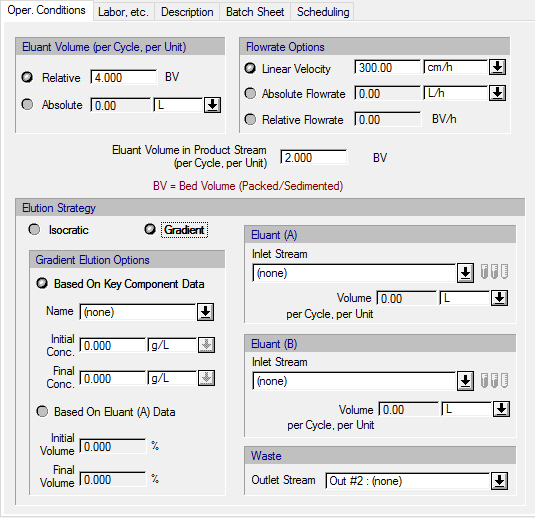

This tab appears on the interface dialog of the following operation:
The following table shows a brief description of the variables appearing in this tab. The table also displays their default values and their generally acceptable range:
|
Variable |
Default Value |
Range |
|
|
||
|
◙ Relative Eluant Volume (per Cycle, per Unit) (BV) |
4.0 |
Positive |
|
◙ Absolute Eluant Volume (per Cycle, per Unit) (L) |
0.0 |
Positive |
|
◙ Linear Velocity (m/h) |
0.0 |
Positive |
|
◙ Absolute Flowrate (m3/h) |
0.0 |
Positive |
|
◙ Relative Flowrate (BV/h) |
0.0 |
Positive |
|
○ Eluant Volume in Product Stream (BV) |
2.0 |
Positive |
|
○ Key Component Name |
<None> |
Any Comp. |
|
○ Initial Concentration Of Key Component (g/L) |
0.0 |
Positive |
|
○ Final Concentration Of Key Component (g/L) |
0.0 |
Positive |
|
○ Initial Volume of Eluant (A) (%) |
0.0 |
Positive |
|
○ Final Volume of Eluant (A) (%) |
0.0 |
Positive |
|
○ Eluant (A) Inlet Stream |
<None> |
Any Input Port |
|
● Eluant (A) Volume per Cycle, per Unit (L) |
0.0 |
Positive |
|
○ Eluant (B) Inlet Stream |
<None> |
Any Input Port |
|
● Eluant (B) Volume per Cycle, per Unit (L) |
0.0 |
Positive |
|
○ Waste Outlet Stream |
<none> |
Any Output Port |
Symbol Key: ○ User-specified value (always input); ● Calculated value (always output); ◙ Sometimes input, sometimes output
The following list describes the available specification choices in this tab; for more details on how these are implemented, see Column Elution (Simplified): Modeling Calculations.
•Gradient Elution...
The gradient buffer is generated by mixing two different buffers in continuously varying ratios. In that case, you need to identify the two buffer streams (A and B). Then, you can either specify the initial and final concentrations of a ‘key component’ in the gradient buffer, or the initial and final volumes of buffer A in the gradient buffer. Based on these, the program will calculate the volumes of buffers A and B in the gradient buffer.
When the initial and final concentrations of a key component are specified, these values must be between that component’s concentrations in the two buffers.
•Composition of Eluant Streams...
To specify the composition of an eluant stream, click on the Edit Composition button next to the stream selection box. That brings up the dialog of that stream and allows you to specify its composition. Please note that the flowrate of that stream will be adjusted by the elution model during simulation.